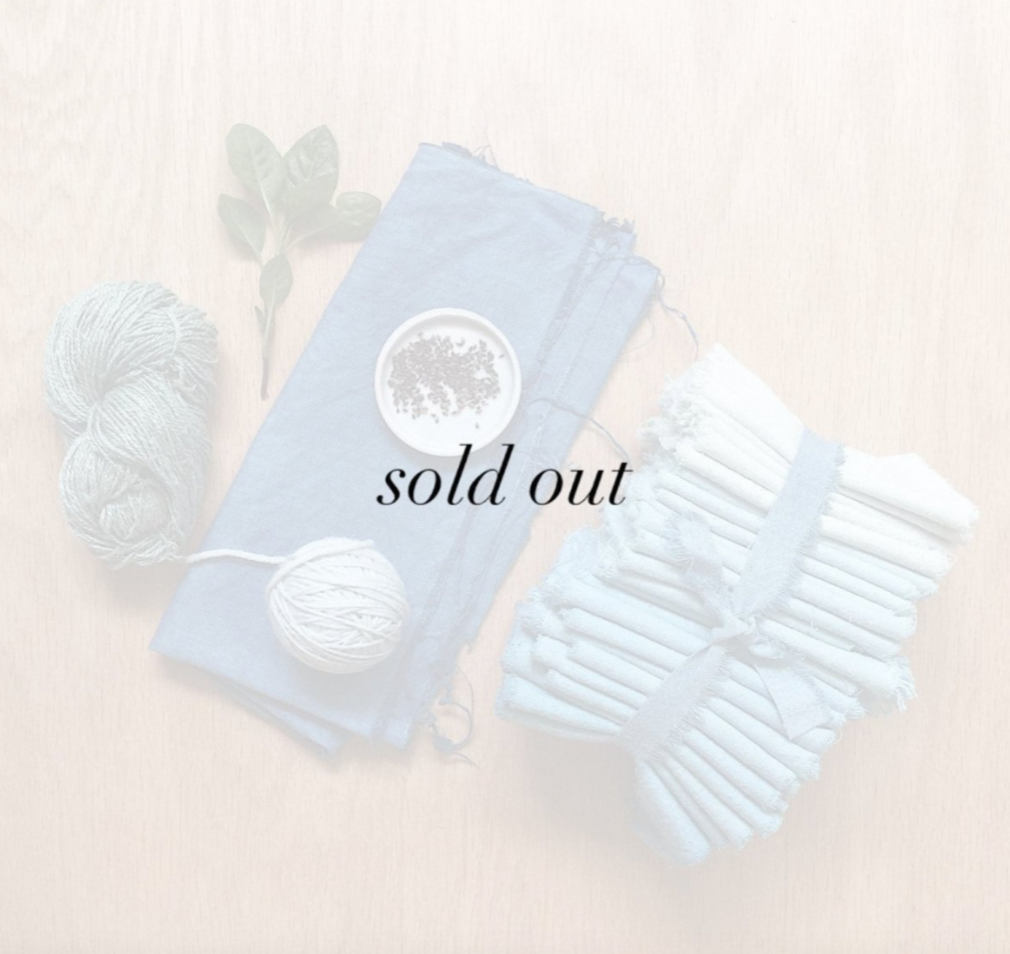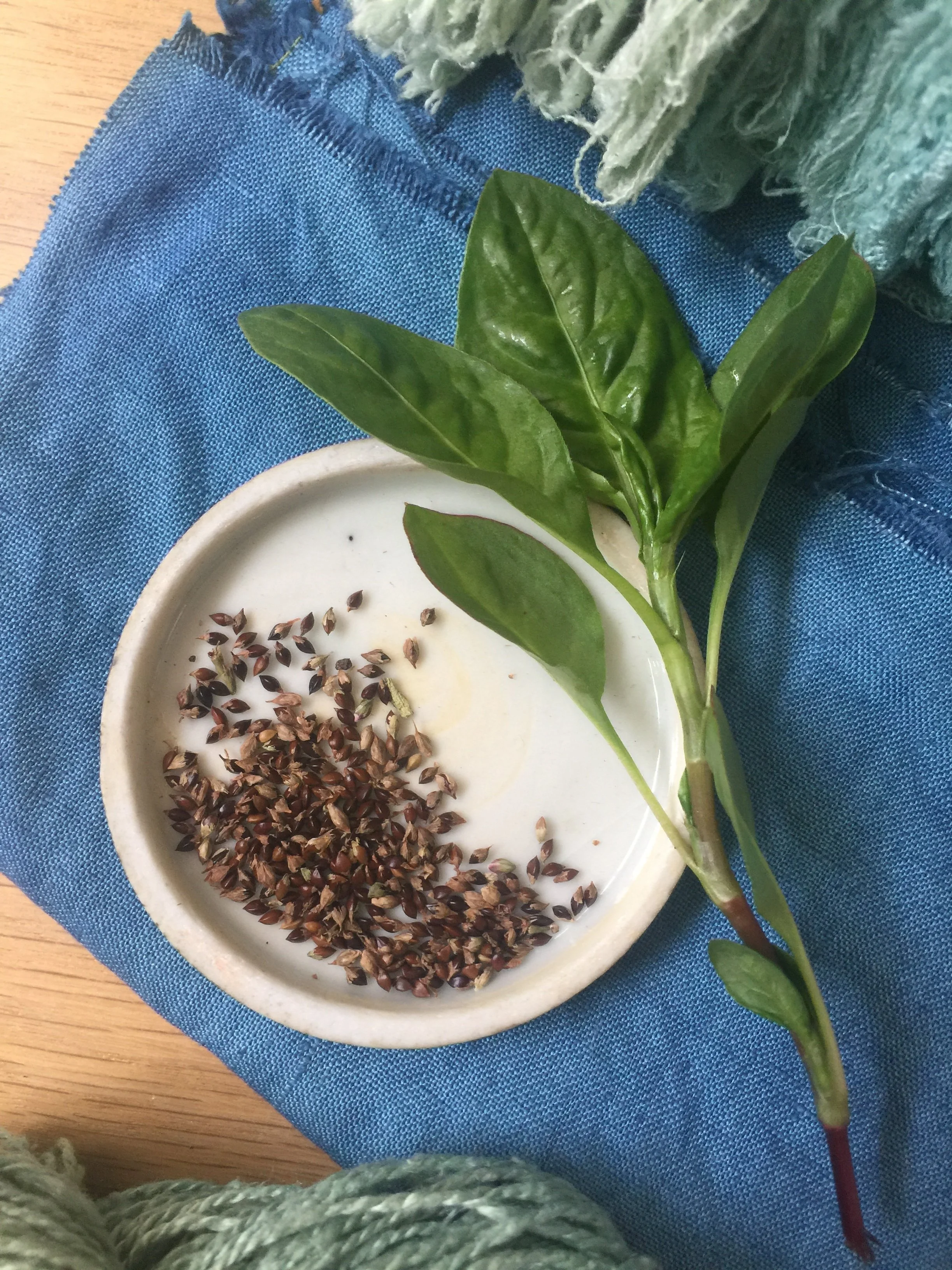Japanese Indigo Seeds- Persicaria tinctoria












Japanese Indigo Seeds- Persicaria tinctoria
My Seeds for 2025 have sold out.
If you missed this seed sale…
I highly recommend purchasing from
Grand Prismatic Seed
This year they have 3 VARIETIES of Japanese Indigo !!
For friends in the UK- I highly recommend purchasing from
For friends in EUROPE- I highly recommend purchasing from
—————
Approximately 250 seeds per pack -Seed orders will take 5-8 days to ship-
-Due to Customs regulations- Seeds SHIP WITHIN THE US ONLY- see below for suggestions to purchase seeds in the UK & EUROPE
This year I have TWO TYPES of Sister Varieties of the same species: Persicaria tinctoria - SENBON & CHIJIMIBA (learn more about each variety below)
Learn Indigo GROWING & DYEING in my
FRESH INDIGO & WOAD Lesson
Japanese Indigo (Persicaria Tincotoria -or- Polygonum Tintorium') is a favorite variety of indigo bearing plant to grow in temperate to hot areas. The plant belongs to the buck wheat family and produces a beautiful blue green aqua color on silk and wool (protein fibers) using a very simple 'fresh leaf' method outlined here on my blog. If you grow enough (more than a few plants worth) and have sufficient leaf weight you may also like to try extracting the indigotin from the leaves to create an indigo vat to dye true indigo blues on all types of natural fibers. I teach this and more in my Fresh Indigo Online Workshop.
Extracted indigo can also be used to make indigo pigment paint for printing and painting. Instructions on germinating, growing, and harvesting your indigo are included with your seed order. Sow indoors 6 weeks before the last threat of frost in your area for a jump start on the season to give yourself multiple harvests throughout the summer and early fall, or directly in the ground in full sun with plenty of water during the spring and a deep weekly watering during the summer. Amend your soil with a natural source of nitrogen for the healthiest plants and the most leaves!
This year I have TWO TYPES of Sister Varieties of the same species: Persicaria tinctoria - SENBON & CHIJIMIBA
Senbon Plant Characteristics:
lighter green, more delicate, tender leaves
a plant profile that is more low lying
Senbon & other varietals of Persicaria with tender leaves are a great choice for the dyer interested in quicker pigment extractions with higher blue yield
Chijimiba (also known as ‘Crinkle’ or ‘Ripple’ Leaf) Plant Characteristics:
darker green, tougher, waxy leaves
a plant profile that is generally more upright
goes to flower and then to seed quicker- this is great for regions with shorter summers- allowing for seed collection before the first frost in colder climates (Japanese Indigo is not frost/freeze tolerant)
I have noticed that my Chijimiba plants are generally more tolerant of high heat, direct sun, scorching summer days, and seem to endure the stress of periods of less water (during times I forgot to turn on my irrigation) with more plant vitality- essentially this variety tends to be less dramatic- just a bit less of a Dye Garden Diva than my old stand-by Senbon.
With a waxier tougher leaf, Chijimiba indigo leaves can take more time to dye fabric with the Fresh Leaf Indigo Dyeing method (blender & salt rub methods)- TIP: Soak your Chijimiba leaves in cool water for a few hours to overnight (I suggest storing in the fridge to keep cool to avoid inadvertantly breaking down of the leaves too much) before dyeing. I have found this to improve the Fresh Leaf Dyeing process with Chijimiba variety- resulting in deeper more saturated blue colors than when starting with unsoaked leaves.
In my trials of pigment extraction there is quite a difference between the colors of blue pigment from the 2 varieties with the Senbon being shades darker. BUT The paint I made made with equal amounts of pigment for each type of indigo is very similar- the only discernible difference being the tone with Chijimiba pigment paint being slightly warmer.
So my take-aways from my Indigo Plant Variety Pigment Extraction Trials:
✔️Grow plants of a new variety in your garden- you may be surprised pleasantly with how they behave & produce in your region.
✔️When it comes to Indigo Pigment: Try not to consume yourself too much with pigment depth & saturation- in my experience, even medium blue, pale blue, gray blue, & green toned blue pigment still makes wonderful dye for Vats & beautiful paints!
For those interested in growing enough indigo for extracting pigment to then use in creating your own homegrown blue indigo vat or for making paints from your pigment- I recommend my Fresh Indigo + Woad Lesson outlining my detailed growing and cultivation strategy including harvesting, dyeing, and saving seed.
You can also learn quite a bit about what to do with your Fresh Indigo Plants- direct dyeing, extracting pogment, making indigo vats directly from leaves, and how to make an indigo vat from dried leaves. Fresh Indigo Online Workshop
Please sow this coming season (2025), as germination rate diminishes after one year. See the Fresh Indigo + Woad Lesson. to learn more about cultivating this plant. And read my blog post on my favorite way to use homegrown indigo- Fresh Leaf Indigo Dyeing!
My Fresh Indigo Workshop will guide you through various processes of working with your homegrown indigo- including how to fresh leaf dye in various ways, extract pigment and create a whole spectrum of color with indigo leaves alone (indigo contains other colorants beyond blue!). It comes with over 3 hours of video instruction and multiple info-packed PDF’s complete with resources, process tips & explanation, and step by step instruction.
If you end up saving INDIGO LEAVES TO DRY- Learn my DRIED LEAF VAT here in my INDIGO VAT WORKSHOP
The dried leaf vat is a very special organic method using ANY amount of dried Indigo Leaves (‘Persicaria tinctorial’). Summer is BUSY! Spend more time enjoying the outdoors & less time stressing over extracting or dyeing with all your fresh indigo leaves. You can DRY the leaves to store for future off season dye Vat making without the lengthy process of extracting, oxidizing & settling pigment first.
It was previously thought that at minimum 7kg / 15 lbs (multiple year’s worth of dried leaves for most growers) is needed to process/compost & make an Indigo Vat, but NOW you can use my dried leaf vat recipe to process your dried indigo leaves in Practically ANY QUANTITY to make an organic vat (I’ve tested this method with as little as 30grams of dried leaves with success!) ~ AND with NO Thiox or Hydros (synthetic indigo reducers). AND this recipe includes extracting yellow from the SAME dried leaves to overdue & make GREEN!
-Seed orders will take 5-8 days to ship-
